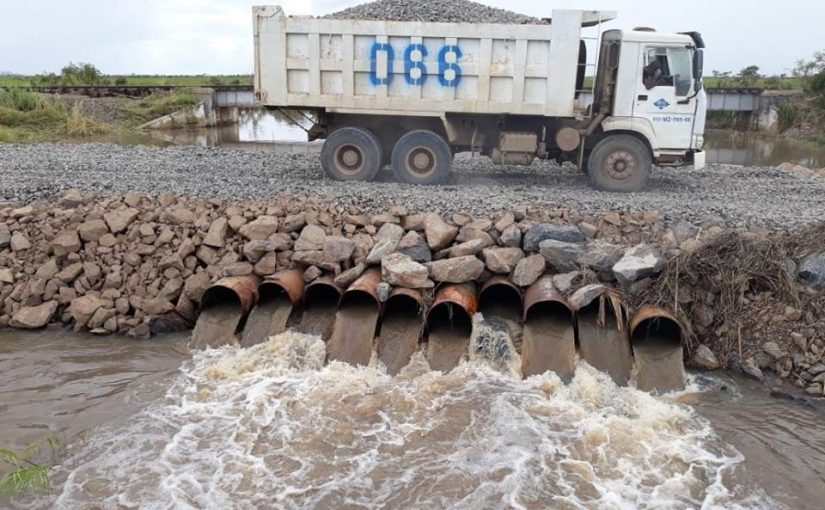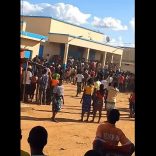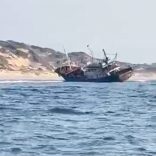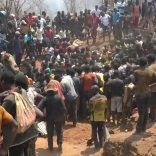Three jihadists 'give a lecture' in Mocímboa mosque – AIM report | Watch
Mozambique: Many await rescue; Beira has water, electricity; road to open Monday – Hanlon

New bypass at Lamego, Nhamatanda. Photo: INGC
Electricity has been restored to water pumping and treatment stations by the government water agency FIPAG, so Beira and Dondo now have clean water. Electricity has been restored to part of the city. The port is open, the railway line was opened yesterday.
Bypasses are being built around the washouts of the main EN6 road which links Beira to the rest of the country and the road should open Monday, Environment Minister and Emergency Coordinator Celso Correia said in his briefing this morning. This will allow larger quantities of food and other supplies to be to be brought to flooded areas in Nhamatanda, west of Beira, and to the city itself.
@CycloneIDAI, the work on temporary road deviation is about to end in Nhamatanda area to connect Beira to the rest of the Country. @Jvrs1928 ,@ALMALondonD pic.twitter.com/CZOFbOsnyW
— Carlos Novela (@CarlosNovela15) March 22, 2019
Flood waters are dropping, but only slowly, and rain has largely stopped. But the flooded area remains a huge inland lake 100 km long and up to 30 km wide. Rescue continues, largely by local boats. Sebastian Stamp, OCHA representative, said there were no longer people in trees, but still many people taking refuge on roofs – often having brought food up to the roofs which they are trying to dry now that the rain has stopped. The Red Cross reports 40 prisoners and guards still trapped on the roof of the Buzi jail.
Reports of many dead in Nhamatanda – WFP delivered food aid here for the first time today, a week after the cyclone hit. pic.twitter.com/2HVy4Jjdn4
— Piers Scholfield (@inglesi) March 22, 2019
Conditions are being improved in the accommodation centres, which are largely in damaged schools and public buildings. There have been no disease major outbreaks yet and attempts are being made to provide clean water and sanitation, but with so much polluted water, cholera and perhaps typhoid expected; malaria is endemic.
There is no realistic death toll, but it is already over 1000 in the three countries Mozambique, Malawi and Zimbabwe. Bodies are still being found. Manica governor Manuel Rodrigues said 75 bodies were found floating in the Mussapadzi river in Dombe, in Sussundenga district. Bodies have been found floating in the Pungue River in Nhamatanda. The morgue in Beira’s man hospital is overflowing with dozens of bodies, reports AFP.
Maior parte dos óbitos em conexão com o #CycloneIdai foi registado em Nhamatanda, disse Celso Correia sem fazer a distribuição dos números. #IDai
— Alexandre (@AllexandreMZ) March 23, 2019
Food remains an issue and some people have eaten little for a week. A warehouse in Beira was broken into Wednesday, according to AFP.
The storm knocked down pylons which disrupted electricity exports from Mozambique’s Cahora Bassa hydropower dam to South Africa, causing power cuts there, It has also curbed fuel supplies to Zimbabwe from a pipeline that originates in Beira, reports Bloomberg.
Severity of cyclone due to climate change
It is impossible to attribute an individual cyclone to climate change – Mozambique regularly has cyclones. But climate change raises the surface temperature of the sea water, which increases the intensity of cyclones, and this is happening in the region. “There is a climate change component which is intensifying the storms and increasing their reach,” and is clearly true with this cyclone, explained Dr Jennifer Fitchett, physical geography researcher, University of the Witwatersrand. But it is impossible to say how much: “for one particular storm it would be very difficult to say that there is a given proportion of that storm of its severity that is a direct result of climate change.” BBC interview: https://www.bbc.co.uk/sounds/play/p0748842 at 12 minutes into the programme
By Joseph Hanon













Leave a Reply
Be the First to Comment!
You must be logged in to post a comment.
You must be logged in to post a comment.